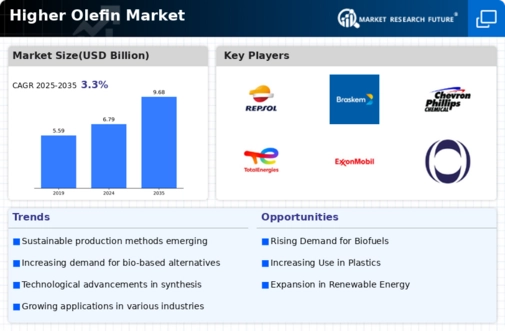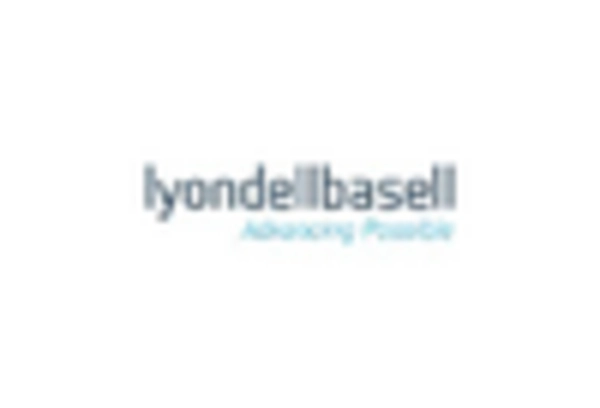Rising Demand for Petrochemicals
The increasing demand for petrochemicals is a primary driver of the Higher Olefin Market. As industries such as automotive, construction, and consumer goods expand, the need for olefins, which serve as key feedstocks, rises. In 2023, the petrochemical sector was valued at approximately 600 billion USD, with projections indicating a compound annual growth rate of around 5% through 2030. This growth is likely to bolster the Higher Olefin Market, as olefins are essential for producing various chemicals and materials. The versatility of higher olefins in applications ranging from detergents to lubricants further enhances their market appeal, suggesting a sustained upward trajectory in demand.
Innovations in Production Technologies
Innovations in production technologies are reshaping the Higher Olefin Market. Advanced catalytic processes and improved separation techniques are enhancing the efficiency of olefin production. For instance, the adoption of metathesis and oligomerization processes has shown potential in increasing yield and reducing energy consumption. As of 2023, the average energy consumption in olefin production has decreased by approximately 15% due to these advancements. This trend not only lowers operational costs but also aligns with sustainability goals, making the Higher Olefin Market more attractive to investors. The continuous evolution of production technologies is expected to drive further growth and innovation in the sector.
Regulatory Support for Sustainable Practices
Regulatory support for sustainable practices is becoming a pivotal driver in the Higher Olefin Market. Governments are increasingly implementing policies that promote the use of bio-based and environmentally friendly feedstocks for olefin production. For example, regulations aimed at reducing carbon emissions are encouraging manufacturers to adopt greener technologies. In 2023, approximately 30% of olefin production was derived from renewable sources, a figure that is expected to rise as regulations tighten. This shift not only aligns with The Higher Olefin Industry favorably in the eyes of consumers and investors who prioritize eco-friendly products.
Expanding Applications in End-User Industries
The expanding applications of higher olefins across various end-user industries significantly influence the Higher Olefin Market. Higher olefins are increasingly utilized in the production of surfactants, lubricants, and polymers, which are essential in sectors such as personal care, automotive, and packaging. The personal care industry alone is projected to reach a market size of 500 billion USD by 2025, with higher olefins playing a crucial role in formulating high-performance products. This diversification of applications not only enhances the market potential but also encourages manufacturers to innovate and develop new products, thereby driving the Higher Olefin Market forward.
Growing Investment in Research and Development
Growing investment in research and development (R&D) is a crucial driver for the Higher Olefin Market. Companies are increasingly allocating resources to innovate and enhance the efficiency of olefin production processes. In 2023, R&D expenditures in the chemical sector reached around 20 billion USD, with a significant portion directed towards olefin technologies. This investment is likely to yield breakthroughs that improve yield, reduce costs, and enhance product quality. Furthermore, as competition intensifies, firms that prioritize R&D are better positioned to capture market share, suggesting that the Higher Olefin Market will continue to evolve and expand in response to these advancements.


















Leave a Comment